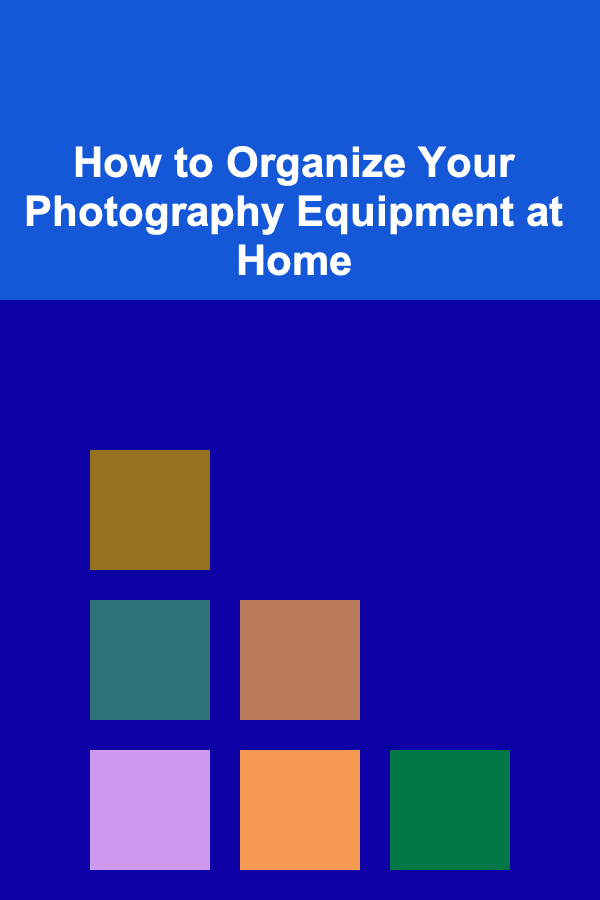
How to Organize Your Photography Equipment at Home
ebook include PDF & Audio bundle (Micro Guide)
$12.99$5.99
Limited Time Offer! Order within the next:

As a photographer, whether you're a hobbyist capturing moments or a professional working on client projects, keeping your photography equipment organized is crucial. An organized setup not only saves time but also enhances your creativity by allowing you easy access to the tools you need. This comprehensive guide aims to help you systematically organize your photography gear at home, ensuring that everything is easily accessible while maintaining an aesthetically pleasing environment.
Understanding the Importance of Organization
1. Efficiency and Accessibility
An organized space allows for quick retrieval of equipment, minimizing downtime when setting up for shoots. Knowing precisely where everything is located helps streamline your workflow, enabling you to spend more time focusing on your craft.
2. Protection of Equipment
Proper organization protects your gear from damage. Camera bodies, lenses, and accessories are delicate items that can easily be harmed when stored incorrectly. Using appropriate storage solutions reduces the risk of accidents and prolongs the lifespan of your equipment.
3. Enhanced Creativity
A clutter-free workspace fosters creativity. When your equipment is well-organized, it can inspire you to experiment and explore new ideas without the distraction of chaos.
4. Preparedness for Opportunities
Photography often requires spontaneity. Being organized means you can grab your equipment and head out the door quickly whenever inspiration strikes or an unexpected opportunity arises.
5. Professionalism
For professional photographers, organization reflects professionalism. A tidy workspace not only impresses clients but also creates a positive impression during portfolio reviews or meetings.
Step-by-Step Guide to Organizing Your Photography Equipment
Step 1: Assess Your Equipment
a. Inventory Your Gear
Start by taking an inventory of all your photography equipment. This may include:
- Cameras
- Lenses
- Tripods and stabilizers
- Lighting equipment (strobes, softboxes)
- Batteries and chargers
- Memory cards
- Camera bags and cases
- Accessories (filters, remote triggers, etc.)
b. Evaluate Condition
Check each item for cleanliness and functionality. Ensure your equipment is in working order, and clean any gear that requires maintenance.
c. Identify Frequency of Use
Determine which items you use most frequently. This assessment will guide you in deciding where to store items and how accessible they should be.
Step 2: Declutter and Discard
a. Remove Unused Items
Go through your equipment and identify items you no longer use or need. Consider selling or donating gear that's in good condition but no longer serves a purpose in your photography practice.
b. Organize by Category
Group similar items together. For example, keep all camera bodies in one area, lenses in another, and lighting equipment separately. This categorization simplifies the organization process.
c. Create a "Maybe" Box
If unsure about certain items, create a "maybe" box. Set a timeline (e.g., six months) to revisit these items. If you haven't used them in that time, consider parting with them.
Step 3: Choose Appropriate Storage Solutions
a. Shelving Units
Install shelving units in your designated photography area. These shelves can hold camera bags, light stands, and other larger pieces of equipment. Use adjustable shelves to accommodate varying sizes.
b. Drawer Systems
Use drawer systems for smaller items like batteries, cables, and memory cards. Label each drawer for easy identification.
c. Bins and Containers
Invest in clear bins or containers to store accessories such as filters, lens caps, and cleaning supplies. Clear containers allow you to see contents at a glance without opening each one.
d. Wall-Mounted Solutions
Consider wall-mounted racks or pegboards for hanging lightweight items such as tripods, umbrellas, or even some camera bags if space permits. This maximizes vertical space and keeps essential items within reach.
Step 4: Optimize Your Workspace
a. Designate a Specific Area
Choose a specific area in your home for your photography gear. This could be a dedicated room, closet, or even a corner of a larger space. A defined area helps contain clutter and maintains focus.
b. Layout and Accessibility
Arrange your equipment based on frequency of use. Keep commonly used items at eye level and in easy-to-reach locations, while less frequently used items can be stored higher or further back.
c. Create a Workflow
Design your space around your workflow. If you edit photos in the same area, set up a designated space for your computer and monitors that complements your photography gear layout.
Step 5: Protective Measures
a. Use Proper Cases
Invest in high-quality padded cases for your cameras and lenses. These cases offer protection against drops and impacts while traveling or storing gear.
b. Environmental Control
Keep your photography equipment in a climate-controlled environment. Avoid storing gear in damp areas, such as basements, to prevent mold growth. Consider using silica gel packets to absorb moisture.
c. Maintain Equipment
Regularly check and maintain your equipment. Clean lenses and camera bodies after use and ensure batteries are charged and functional.
Step 6: Establish a Maintenance Routine
a. Regular Check-Ups
Schedule regular inventory checks to ensure all equipment is accounted for and in working order. This could be quarterly or semi-annually.
b. Cleanliness
Develop a routine for cleaning your gear after each shoot. Allocate a specific day of the week for this task to maintain organization.
c. Update Inventory
Whenever you acquire new gear or part with old items, update your inventory list. Keeping an accurate inventory can help you track your investments and simplify insurance claims if needed.
Creative Ideas for Organizing Your Photography Equipment
1. Portable Photography Kit
Create a portable photography kit that includes essential gear for impromptu shoots. This kit should be compact and easy to grab, containing items like:
- A camera body
- A versatile lens
- Extra batteries
- Memory cards
- A small tripod
2. Themed Equipment Boxes
If you specialize in different types of photography (portrait, landscape, event), consider creating themed boxes for each genre. This organization method allows you to grab the entire box when preparing for specific shoots.
3. Digital Cataloging
Maintain a digital catalog of your equipment, including details such as purchase date, warranties, and serial numbers. Use spreadsheet software or specialized inventory apps for easy tracking.
4. Shooting Spot Checklist
Create a checklist of must-have items for different shooting locations. This practice ensures you pack all necessary gear before heading out, minimizing the chance of forgetting something important.
5. Visual Inspiration Board
Consider incorporating a visual inspiration board in your workspace. Pin up photos, ideas, and concepts that motivate you. This addition can serve both as decoration and a creative prompt.
Common Challenges and Solutions
1. Limited Space
Challenge: Many photographers struggle with limited storage space for their gear.
Solution: Maximize vertical storage and utilize underutilized areas like the tops of cabinets. Consider modular shelving that can be adjusted as your collection grows.
2. Overwhelming Clutter
Challenge: Accumulated gear can create overwhelming clutter, making organization feel daunting.
Solution: Break down the organization process into manageable tasks. Focus on one category at a time, and remember that progress is better than perfection.
3. Changing Needs
Challenge: As your photography evolves, so do your equipment needs, leading to disorganization.
Solution: Be proactive about reassessing your equipment regularly. Make adjustments to your organizational system as your style and needs change.
4. Inconsistent Maintenance
Challenge: Maintaining an organized space can be challenging over time.
Solution: Establish a routine for checking in on your organization system. Include family members or fellow photographers in this process if applicable.
Benefits of Organizing Your Photography Equipment
1. Increased Productivity
An organized space enhances productivity, allowing you to transition seamlessly between shooting, editing, and planning.
2. Improved Focus
A tidy environment promotes better focus and concentration. You'll find it easier to dive into creative work when distractions are minimized.
3. Financial Savings
By keeping track of your equipment, you'll avoid unnecessary purchases because you'll know what you already own.
4. Reduced Stress
An organized photography space alleviates stress associated with searching for gear. This peace of mind allows you to enjoy your passion for photography more fully.
5. Long-term Enjoyment
Taking care of your gear extends its lifespan, enabling you to enjoy your photography journey for years to come.
Conclusion
Organizing your photography equipment at home is a rewarding endeavor that pays off in numerous ways---from enhancing creativity and productivity to fostering a sense of control and calm. By following the steps outlined in this guide, you can create a systematic and efficient storage solution tailored to your unique needs as a photographer.
Embrace the process of decluttering and organizing, recognizing that a well-maintained space allows you to focus on what you love most: capturing stunning images and telling compelling stories through your lens. Take pride in your organized photography setup, and let it inspire your artistic endeavors for years to come. Happy shooting!
Reading More From Our Other Websites
- [Personal Care Tips 101] How to Choose Lip Gloss for Sensitive Skin Around Your Lips
- [Home Soundproofing 101] How to Achieve Effective Soundproofing in a Condo: Challenges and Solutions
- [Home Lighting 101] How to Upgrade Your Lighting Fixtures Without Breaking the Bank
- [Rock Climbing Tip 101] Top Classic Bouldering Problems Every Climber Should Try
- [Biking 101] How to Find the Best Bike Trails Near You for Weekend Rides
- [Home Party Planning 101] How to Design a Party Menu That Will Impress Your Guests
- [Home Cleaning 101] Laundry Tips and Tricks: How to Keep Your Clothes Looking New
- [Personal Care Tips 101] How to Use Toner for Brighter and More Even Skin Tone
- [Personal Financial Planning 101] How to Save for a Home: A Step-by-Step Guide to Achieving Homeownership
- [Home Staging 101] How to Plan a Home Staging Timeline

How to Choose the Best Home Security Alarm for Your Property
Read More
How to Choose the Best Tools for Virtual Collaboration
Read More
How to Use Rugs to Define Spaces in Staging
Read More
How to Explore Blockchain for Digital Rights Management
Read More
10 Tips for Conducting Effective Ergonomic Assessments
Read More
Quality Control Inspector: How to Write a Winning Resume
Read MoreOther Products

How to Choose the Best Home Security Alarm for Your Property
Read More
How to Choose the Best Tools for Virtual Collaboration
Read More
How to Use Rugs to Define Spaces in Staging
Read More
How to Explore Blockchain for Digital Rights Management
Read More
10 Tips for Conducting Effective Ergonomic Assessments
Read More